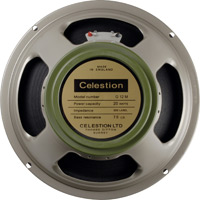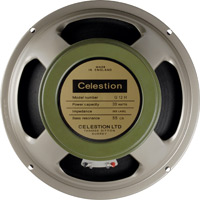Chances are if you ask a player who uses vintage Marshall amplifiers to name their favorite speaker, they’ll either call out the G12M or G12H “Pre-Rola Greenback” speaker. These two speakers literally defined the sound of rock since the 1960’s and have continued to do so ever since.
The original speakers changed over the years – significantly so from the mid ’70s and onward. Between the use of stiffer cone material, fiber and various dampening and other techniques to “improve” the speaker, something got lost with the tone according to many players. The demand for the original series never waned as a result.
To provide a brief bit of history on these models, let’s start with the G12M. The G12M in 16 ohm version was originally most-commonly labeled as a T1221 coded speaker and rated at 20 watts. This was the speaker used in the majority of Marshall cabinets from circa 1966 and onward, whether they were in the 1 x 12 mini-bluesbreaker 18 watter, 2 x 12 “Bluesbreaker” combo, or in 4 x 12 stack lead guitar cabinets. The sound of the G12M with its ceramic magnet and easy cone movement provided plenty of midrange crunch along with nice compression of the low-end when the speakers were pushed. In other words, these were fantastic rock and blues speakers and sounded very different from the Alnico type speakers used in other Marshalls as well as Voxes. The G12M was much more full-bodied in tone and retained good clarity.
By approximately late 1968, the G12M shifted from 20 to 25 watts in power handling capability and stayed this way. The heavy-duty speaker option at the time was the G12H, and with its larger and heavier magnet and stiffer cone had a handling rating of 30 watts (conservatively rated I’d say).
The G12H not only handled more power, but it was also a much more efficient speaker. Using the same cabinet equipped with either a G12M or a G12H, one will instantly recognize the G12H as being quite a bit louder of a speaker. While the G12M’s inefficiency gives it a 96 dB sensitivity rating, the G12H is rated at a full 100dB sensitivity. That’s the difference approximately in volume level between a 100 watt and a 50 watt amp at full power.
The tone of the G12H is also dramatically different than the G12M. While the G12M compresses thickly and has a creamy midrange, the G12H is a fairly flat-response speaker. It won’t overemphasize any particular frequency, and there is also more high-end available on tap as well. The G12H retains a stiffer feel, which is well suited for the bass instruments it was primarily designed to have played through it. Jimi Hendrix is probably the most famous G12H user however – it has been said that he blew up one too many G12Ms and then made the switch.
Celestion Heritage Series Greenback G12M and G12H Reissues in Depth
The new Heritage Series G12M and G12H Greenbacks were designed to be faithful reissues of the originals from the ’60s. According to Celestion, they adhered precisely to the design notes and specifications of the original speakers and used the exact same materials and construction techniques. Indeed cosmetically, the detail of the speakers are true to the original – not only with just the greenback magnet cover and appropriate labeling on the sticker, but the cone itself, dust cover, and even the gasket material surrounding the speaker cone are just like the originals.
We first experienced the reissue Heritage G12M when it was loaded into the Marshall 1974x reissue 18 watt Handwired combo. We were extremely impressed then with the single speaker and looked forward to the opportunity to try four of these speakers together some day in a cabinet and run against a cabinet loaded with the originals. The day had arrived and we were excited!
Looking at the specifications of the G12M and G12H, everything is “right” on paper. But would these speakers truly be able to deliver the goods of the famous pre-Rola era greenbacks?
G12M General specifications
| Nominal diameter | 12″, 305mm |
| Power Rating | 20W |
| Nominal impedance | 8Ω and 15Ω |
| Sensitivity | 96dB |
| Chassis type | Pressed steel |
| Voice coil diameter | 1.75″, 44.5mm |
| Voice coil material | Round copper |
| Magnet type | Ceramic |
| Magnet weight | 35oz, 0.99kg |
| Frequency range | 75-5000Hz |
| Resonance frequency, Fs | 86.9Hz |
| DC resistance, Re | 6.57Ω |
Mounting Information
| Diameter | 12.2″, 309mm |
| Overall depth | 5.1″, 130mm |
| Magnet structure diameter | 5.9″, 150mm |
| Cut-out diameter | 11.1″, 283mm |
| Mounting slot dimensions | 0.31″, 7.9mm Ø |
| Number of mounting slots | 4 |
| Mounting slot PCD | 11.7″, 297mm |
| Unit weight | 7.9lb, 3.6kg |
First up was the G12M. Using our favorite vintage Marshall Super Lead and Les Paul, the Heritage G12M reissue in the 4 x 12 closed back cabinet sounded, in a word…glorious. Its midrange and crunch were both extremely smooth, and when turned up it achieved the famous bottom end compression the speaker itself is famous for. The highs were suppressed to sweeten the overall tone, but the sound could still cut without being dull. The original G12Ms are my personal favorite speakers when matched with a Lead-series Marshall for this reason as they tame much of the top-end brightness that the amps can often produce in excess.
The G12M is a great pick for the classic-rocker and bluesman who also wants a response that is a bit more relaxed and laid back. The best pre-Rola originals will feel as if they are an extension of your tube amplifier in how they compress and react dynamically to your playing. The reissue Heritage G12M responded in very much the same way and was very satisfying to both listen to and “feel”. For good measure, we put in plenty of time with the Stratocaster as well to judge this dynamic sense since the Les Paul really is much more of a balls-out guitar in output compared to a Strat. The Heritage G12M didn’t disappoint.
Next up was the Heritage G12H. True to the original, the Heritage G12H turned out to be a completely different animal from the G12M. It had the characteristic faster response with a tone palette that felt much more neutral. It also was brighter on the top and overall had more of a solid feel compared to the G12M while still retaining the crunchy characteristic of the original Celestion’s voice.
Sonically, with its larger magnet, one would immediately think that the bass of the G12H would be stronger. In fact, the G12H can reproduce more bass (you’ll hear the difference immediately when using a bass guitar), but it didn’t FEEL like it had more bass available to it compared to the G12M when using a 6-string guitar. Why is that? Well, this is simply because the G12H won’t compress like the G12M – it remains solid and unwavering. In a way it reminded me of the difference between an EL34 tube with its softer compression characteristics and a 6L6 or 6550 tube with its cleaner headroom.
As I continued to play through the G12H-loaded cabinet, it also reminded me again what a good choice the H would be for harder rock and metal guitarists as it was definitely aggressive. The Heritage G12H also proved itself as a much louder speaker when compared to the G12M.
I put some time in with the G12H and a ’68 plexi Marshall Super Bass and this is where the characteristics of the speaker seemed to personally shine the most. The Super Bass allows a bit more low-end frequency response through and the G12H produced those lower overtones on the guitar with authority. The result was a very big sound that covered a wide frequency range.
G12H General specifications
| Nominal diameter | 12″, 305mm |
| Power Rating | 30W |
| Nominal impedance | 8Ω and 15Ω |
| Sensitivity | 100dB |
| Chassis type | Pressed steel |
| Voice coil diameter | 1.75″, 44.5mm |
| Voice coil material | Rounded copper |
| Magnet type | Ceramic |
| Magnet weight | 50oz, 1.42kg |
| Frequency range | 55-5000Hz |
| Resonance frequency, Fs | 78.9Hz |
| DC resistance, Re | 6.53Ω |
Mounting Information
| Diameter | 12.2″, 309mm |
| Overall depth | 5.3″, 135mm |
| Magnet structure diameter | 6.6″, 168mm |
| Cut-out diameter | 11.1″, 283mm |
| Mounting slot dimensions | 0.31″, 7.9mm Ø |
| Number of mounting slots | 4 |
| Mounting slot PCD | 11.7″, 297mm |
| Unit weight | 10.4lb, 4.7kg |
In the end, Celestion has proven that they haven’t lost the knack for building a true and proper reissue of two of its most famous and coveted speakers. I can say with confidence that those familiar with the originals should not be disappointed with this series. If you’re looking for an alternative to the original and scarce vintage versions, rest assured that the Celestion Heritage series have our full endorsement and sound and feel amazing. Reviews like these are always easier for us as well as being much more fun to write – I’m proud to see that Celestion has done such a tremendous job with the Heritage series G12M and G12H models. Kudos and thanks go to their team from LegendaryTones!


So my 1992 8 ohm Greenback made in the UK would be what, then, as it pertains to this article ?
Yours would be the standard issue G12M-25. In my opinion, this speaker, whether made in the UK or China, to my ears sounds tonally identical. The Heritage series G12M 20 watter is an entirely different animal. It actually sounds and responds very closely to the original G12Ms (and that’s compared to either the 20 or 25 watt original variety which are extremely similar) that had the pre-Rola pulsonic cones. The standard 25 watter you have is a good speaker, but it is brighter and doesn’t quite have the response of the originals or the Heritage versions. Not a bad speaker, but lacks the same level of low-end compression that makes the original and Heritage versions so good.
some confusion between the Heritage 12M and EVH. The former is 20W and latter 25W. Yet, it is identical??
Hi Michael, no, both are rated at 20 watts. At least by the specs I’ve seen unless they’ve changed. Check out the pic here of the magnet cover of the EVH.
http://www.guitarcenter.com/Celestion/G12-EVH-Van-Halen-Signature-Guitar-Speaker.gc?CJAID=10432687&CJPID=3747368&CJSID=idqimhadlp0004m600279
it should say. But my guess is an “H”
The Heritage G12M is a 20W speaker. The EVH is a Heritage G12M speaker with an EVH Can glued onto the magnet so yes they are identical.
Your 1992 8 ohm Greenback made in the UK would be a 25W speaker that Celestion refers to as a G12M “Classic”. The only G12M Greenback Celestion made at that time. The article references your speaker but also focused on the “Heritage” version of the G12M and G12H models. A bit confusing for someone not that familiar with Celestion offerings over the years.
part of the confusion is the Cab. EVH makes a 100 Watt head. 4 X 20=80 Watts.